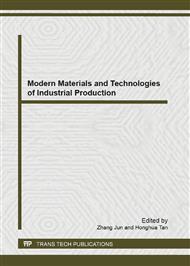p.337
p.341
p.347
p.353
p.358
p.365
p.370
p.375
p.380
The Uncertainty in Sugar Solution Concentration Measurement Based on Density Approach
Abstract:
The concentration of solution used in osmotic process is an important factor to dehydrate water from food, which is an effect to the rate of mass transfer. Therefore, the in line measurement and control of the concentration in osmotic process is taken into account. The density of sugar solution can be computed by volume and weight in order to determine the concentration in degree of Brix. This instrument will complete when accompanied by a statement of its uncertainty. The calibration equation established the relationship between the reading values of sensor and the values of concentration also need to clarify. The objective of this paper is to evaluate the uncertainty of predicted values of calibration equation; therefore, the uncertainty is determined in this study, and to compare the obtained results from the classical method in linear equation and the inverse method. Furthermore, the data from Monte Carlo simulations also are compared to the measured data.
Info:
Periodical:
Pages:
358-364
Citation:
Online since:
September 2013
Authors:
Keywords:
Price:
Сopyright:
© 2013 Trans Tech Publications Ltd. All Rights Reserved
Share:
Citation:


